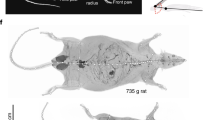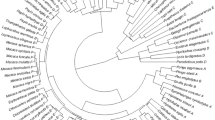Summary
The in vivo bending rigidity and bone mineral content of monkey ulnae and tibiae were measured. Bending rigidity in the anteroposterior plane was measured by an impedance probe technique. Forced vibrations of the bones were induced with an electromechanical shaker, and force and velocity at the driving point were determined. The responses over the range of 100–250 Hz were utilized to compute the bending rigidity. Bone mineral content in the cross section was determined by a photon absorption technique. Seventeen male monkeys (Macaca nemestrina) weighing 6–14 kg were evaluated. Repeatability of the rigidity measures was 4%. Bone mineral content was measured with a precision of 3.5%. Bending rigidity was correlated with the mineral content of the cross section,r=0.899. Two monkeys were evaluated during prolonged hypodynamic restraint. Restraint produced regional losses of bone most obviously in the proximal tibia. Local bone mineral content declines 17 to 24% and the average bending rigidity declines 12 to 22%. Changes in bones leading to a reduction in mineral content and stiffness are discussed.
Similar content being viewed by others
References
Vose, G.P., Kubala, A.L.: Bone strength—its relationship to X-ray determined ash content, Hum. Biol.31:262–270, 1959
Currey, J.D.: The mechanical consequences of variation in the mineral content of bone, J. Biomech.2:1–11, 1969
Orne, D., Borders, S., Petersen, K.: Prediction of bending strength of long bones from measurements of bending stiffness and bone mineral content, J. Biomech. Eng.99:40–44, 1977
Jurist, J.M., Foltz, A.S.: Human ulnar bending stiffness, mineral content, geometry and strength, J. Biomech.10:455–459, 1977
Mather, B.S.: Correlation between strength and other properties of long bones, J. Trauma7:633–638, 1967
Jurist, J., Kianian, K.: Three models of the vibrating ulna, J. Biomech.6:331–342, 1973
Doherty, W.P.: Dynamic responses of human tibiae—application to fracture healing and osteoporosis. Ph.D. Dissertation, Department of Civil Engineering, V. C. SESM 71-18, University of California, Berkeley, 1971
Thompson, G.A., Orne, D., Young, D.R.:In vivo determination of mechanical properties of the human ulna by means of mechanical impedance tests: experimental results and improved mathematical model, Med. Biol. Eng.14:253–262, 1976
Peterson, K.R.: Non-invasive determination of bone stiffness. Ph.D. Dissertation, Department of Mechanical Engineering, Stanford University, 1977
Orne, D.: Thein vivo driving-point impedance of the human ulna: a viscoelastic beam model, J. Biomech.7:249–257, 1974
Orne, D., Mandke, J.: The influence of musculature on the mechanical impedance of the human ulna—Anin vivo simulated study, J. Biomech.8:143–149, 1975
Orne, D., Young, D.R.: The effects of variable mass and geometry pretwist, shear deformation and rotatory inertia on the resonant frequencies of intact long bones: a finite element model analysis, J. Biomech.9:763–770, 1976
Howard, W.H., Parcher, J.W., Young, D.R.: Primate restraint system for studies of metabolic responses during recumbency, Lab Animal Sci.21:112–117, 1971
Cameron, J.R., Mazess, R.B., Sorenson, J.A.: Precision and accuracy of bone mineral determination by direct photon absorptiometry, Invest. Radiol.3:141–150, 1968
Bartley, M.H., Jr., Arnold, J.S., Haslam, R.K., Jee, W.S.S.: The relationship of bone strength and bone quantity in health, disease, and aging, J. Gerontol.21:517–525, 1966
Bell, G.H., Dunbar, O., Beck, J.S., Gibb, A.: Variations in strength of vertebrae with age and their relation to osteoporosis, Calcif. Tissue Res.1:75–79, 1967
Abendshein, W., Hyatt, G.W.: Ultrasonics and selected physical properties of bone, Clin. Orthop.69:294–301, 1970
Currey, J.D.: Differences in the tensile strength of bone of different histological type, J. Anat. (Lond).93:87–95, 1959
Saha, S., Hayes, W.C.: Relations between tensile impact properties and microstructure of compact bone, Calcif. Tissue Res.24:65–72, 1977
Young, D.R., Adachi, R.R., Howard, W.H.: Bone mineral losses during hypokinesis in primates (M. nemestrina), Abstract 46th Annual Scientific Meeting, Aerospace Medical Association, San Francisco, California, April 28–May 1, 1975
Kazarian, L.E., Von Gierke, H.E.: Bone loss as a result of immobilization and chelation: preliminary results inMacaca mulatta, Clin. Orthop.65:67–75, 1969
Semb, H.: The breaking strength of normal and immobilized cortical bone from dogs, Acta Orthop. Scand.37:131–140, 1966
Leon, H.A., Young, D.R.: Bone mineral losses during hypokinesis in primates (M. nemestrina) accentuated by CO2 and aspirin administration, Abstract, 46th Annual Scientific Meeting, Aerospace Medical Association, San Francisco, April 28–May 1, 1975
Author information
Authors and Affiliations
Rights and permissions
About this article
Cite this article
Young, D.R., Howard, W.H., Cann, C. et al. Noninvasive measures of bone bending rigidity in the monkey (M. nemestrina). Calcif Tissue Int 27, 109–115 (1979). https://doi.org/10.1007/BF02441171
Received:
Revised:
Accepted:
Issue Date:
DOI: https://doi.org/10.1007/BF02441171




